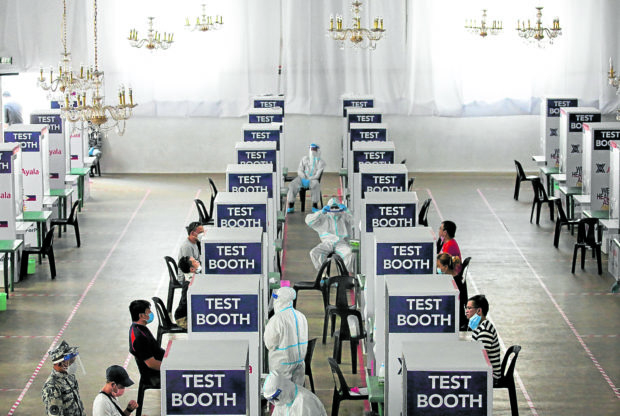
READY FOR TESTING A medical team collects specimens from overseas Filipino workers (OFWs) at a swabbing center set up at Palacio de Maynila events and exhibit center in Manila. The OFWs are given clearances to return to their home provinces once they test negative for the coronavirus. —LYN RILLON
CAGAYAN DE ORO CITY, Misamis Oriental, Philippines — Mina, a domestic worker in Hong Kong, has grown bored waiting for her chance to go home to Misamis Occidental province since arriving in the country early last month.
Along with other overseas Filipino workers (OFWs), she was quarantined in a hotel in Metro Manila. Last week, they were swabbed and were now awaiting test results.
If negative for the coronavirus, Mina can more than comply with the already prolonged isolation and get her certificate of quarantine completion.
But to enlist for her return home, she must still secure a medical certificate and agree to be quarantined for 14 more days when she arrives in Misamis Occidental. Because of this, she said she would just wait for the restrictions to be lifted before deciding to eventually go home.
Remove barriers
On Monday night, President Duterte ordered local governments to remove the barriers for the OFWs’ seamless return to their hometowns.
Dr. Adriano Suba-an, health director in Northern Mindanao, on Tuesday echoed Mr. Duterte’s order, telling local governments not to overburden OFWs seeking to be reunited with their families.
“They have already sacrificed a lot. We should facilitate [their return home], more so if they don’t have signs and symptoms (of COVID-19). Let’s not overkill,” Suba-an said.
Local governments in Mindanao have been wary of repatriated OFWs and stranded residents after several of them had tested positive for COVID-19 when they arrived in their hometowns.
A seafarer from Misamis Occidental, who was in the first batch that was brought home from Manila via a 2GO vessel last month, tested positive for the virus. This was the same trip that carried 23 others who also tested positive in Cebu.
Another person, who went home to Davao City on a sweeper flight from Manila early this month, and an Iligan City resident, who went home from Cebu, both tested positive for COVID-19.
On Monday, some 330 OFWs stranded in Luzon arrived via two sweeper flights at Laguindingan Airport in Misamis Oriental. The passengers had their temperature checked and went through sanitation before stepping into the airport terminal. Nobody showed symptoms of the disease.
The returning OFWs were from Caraga, Northern Mindanao, Zamboanga Peninsula, and the Bangsamoro regions.
Martin Visabella Jr., 47, from Dipolog City, said he arrived in the country on March 16 after being told to go home by his employer. He worked as a hotel crew of a cruise ship based in San Francisco, California.
ScramblingVisabella said he and other OFWs stayed at New Clark City Athletes’ Village in Capas, Tarlac province, for two weeks, and underwent 14-day quarantine after they arrived in Metro Manila.
In the Visayas, officials of Negros Occidental and Bacolod City are scrambling to find places to isolate hundreds of OFWs who have returned home.
Gov. Eugenio Jose Lacson said he and the other officials were not told how many OFWs would arrive, and they had very little time to make arrangements with hotels and pension houses that would serve as quarantine facilities.
Bacolod Mayor Evelio Leonardia had to call for an emergency meeting to prepare for the arrival of the returning OFWs.
At least 468 OFWs arrived in Negros Occidental and Bacolod on Monday, with more expected in the next two days.
They were brought to the provincial quarantine centers in Magalona town and Cadiz City for processing before they were transferred to the hotels.
The Bacoleños were brought to a hotel and a pension house.In Tacloban City, quarantines have been set up for returning OFWs. But if their houses have enough rooms for their mandatory isolation, they would just be allowed to stay home.
Management system
In Batangas, OFWs would be brought home either by “air, land, or sea,” which the Department of Transportation would facilitate, said Abigail Andres, the Department of the Interior and Local Government chief in the province.Andres said at least three hotels and resorts in Lian, Nasugbu and Talisay towns were still hosting OFWs, who were mandated to complete the two-week isolation before going home.
In Baguio, the city government has readied a management system that includes containment, triage and disease management scheme for OFWs, residents and employees.
An OFW unit was put up at Teachers’ Camp, which initially offered 129 beds and was being managed by the Department of Health.
The city has created a “Returning Baguio Residents” system that will be integrated into the local police procedure of easing the return of residents stranded in other places due to the Luzon lockdown.
Ready to welcome
Interior Secretary Eduardo Año said more than 300,000 OFWs were expected to return this year and local governments should be ready to welcome them.
Some 60,000 of them are expected in the next two months, coming mostly from the Middle East, South America and Southeast Asia, Año said.
He warned local officials against rejecting these workers. “To local governments that are too strict and not following regulations, I am warning you, stop that. You cannot say ‘We are zero-COVID, which is why we would not accept OFWs. You can only stay at the pier,’” he said.
Año added: “That can’t be allowed. I myself will make sure to go after you because that is not in accordance with the Bayanihan Act and the orders of our President.”
—Reports from Divina Suson, Jigger Jerusalem, Carla Gomez, Joey Gabieta, Nestor Burgos Jr., Maricar Cinco, Vincent Cabreza, Leila Salaverria and Jerome Aning